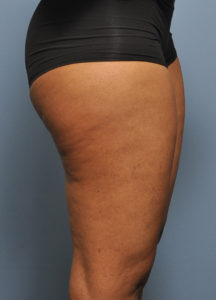
While its appearance is well known, few understand why it is there and what causes it. Cellulite is not really based on being overweight (although thinner people usually have less of it), but rather genetics, hormones, and age play the dominant causes. It clearly appears much more often in women than men due to the different subcutaneous anatomies of the way fat is stored.
From an anatomical standpoint, cellulite refers to the fatty deposits that form uneven and dimpled skin found mainly on the thighs, hips and buttocks of many women. Cellulite is not caused by being overweight. The subcutaneous connective tissue that holds fat is made up of fibers and these fibers act as anchors between the muscles and the skin. Between these fibers are chambers that hold fat cells. Cellulite develops when, for unknown reasons, these connective tissue fibers beneath the skin that compartmentalize the fat shrink and stiffen. This results in areas where the skin is held down while other sections bulge out, resulting in that lumpy “cottage-cheese” appearance. Men are very much less prone to this problem because their connective tissue fibers run more diagonally rather than completely vertical.
The burning and never-ending question is…what can you do for cellulite? What I can say is that there is nothing that you can buy on the internet and slather on the affected areas that will produce a miracle cure. Of course, there are many creams, oils, and lotions promoted to improve cellulite. Time and again these products are proven ineffective, yet millions of consumers still purchase them in hopes of an easy answer. But there are newer and promising treatments that can provide some improvement although most results are not permanent. The search for more permanent solutions, like the Loch Ness monster, is ongoing.
Liposuction is still widely perceived as a cellulite treatment since it removes fat. However, it has proven to not be an effective treatment and can even make it look worse if too much fat is removed or removed too close to the skin. In my Indianapolis plastic surgery practice, I emphasize this point to patients and how we must be careful in performing liposuction in areas underneath cellulite-laden skin.
Pickling or subcision is a procedure that has been used for decades to alleviate scarring from acne and has a more recent history of use in cellulite. The procedure is done by special long instruments that have a cutting edge to them, like a pickle fork. They work by detaching the tight fibers that run beneath the skin that cause cellulite. Unfortunately the initial smoothing benefits are not usually maintained once all swelling has subsided months later. For this reason, cellulite pickling has largely been abandoned. I have recently applied the Smartlipo technology as a ‘laser pickling’ method. The heat from the laser may yield better results in causing a more permanent cellulite improvement but more patient treatments and follow-up are needed.
Several ultrasound and laser external machines, such as TriActive and VelaShape, are FDA-approved and do produce some cellulite reduction benefits. They both use the concept of different energies being driven into the skin toincrease blood flow, improve lymphatic drainage, and tighten a little skin. Their benefits are real but, again, only temporary for many. Maintenance treatments are necessary for sustained benefits.
In conclusion, an effective and permanent solution for reducing the appearance of cellulite does not yet exist. Superficial subcutaneous laser treatments are promising but that still requires an invasive approach. Non-invasive device-driven technologies do work but results require long-term maintenance. If it comes out of a bottle or jar…save your money (and hope) for more proven methods.
Dr. Barry Eppley
Indianapolis, Indiana


